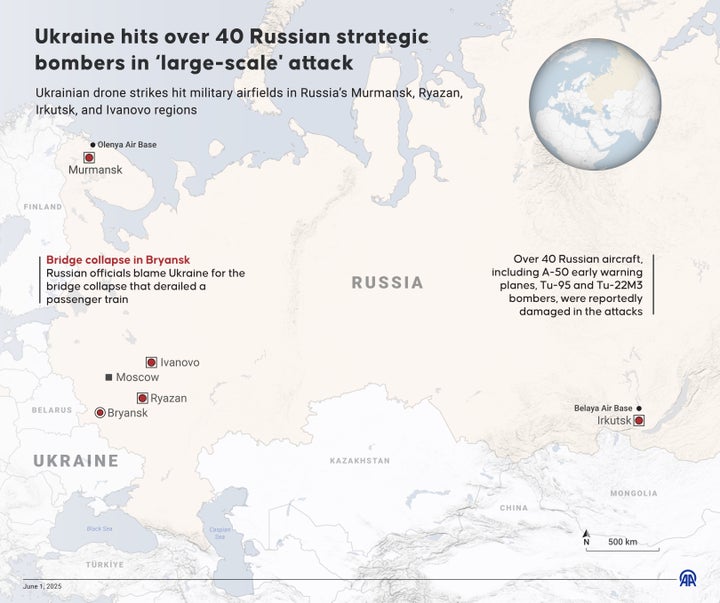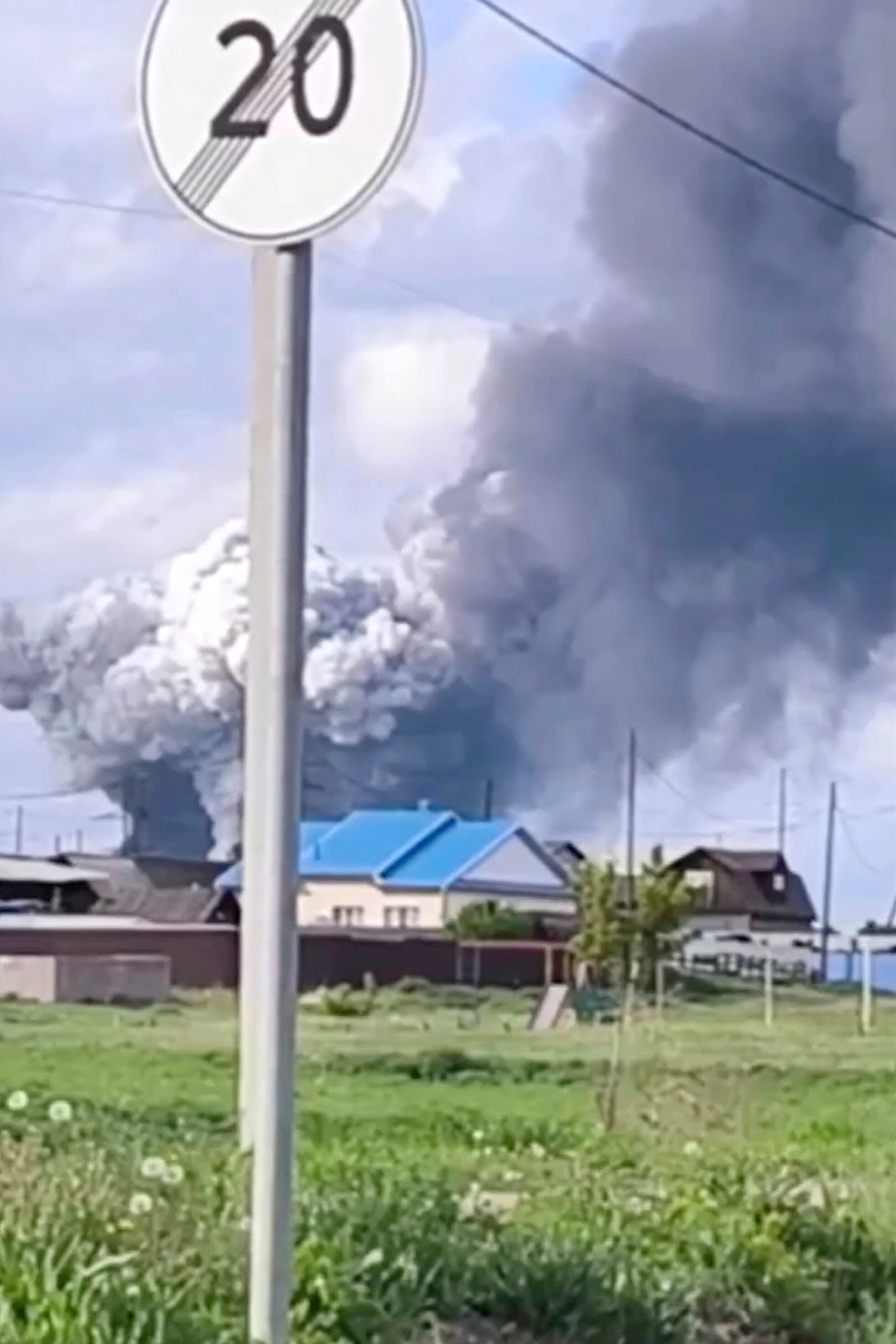Why Ukraine’s Surprise Attack Is Being Called ‘Russia’s Pearl Harbor’
Ukraine’s drone attack on warplanes at Russian air bases as deep into the country as Siberia has shocked U.S. military commentators for its sheer audacity.
The Security Service of Ukraine claimed Sunday’s so-called Operation Spider’s Web had caused considerable damage to Russia, destroying around one-third of its fleet of air missile carriers, some of which can not be produced again, with damages estimated at $7 billion.
Advertisement
Aside from the strategic and financial gut punch to Russian President Vladimir Putin amid stagnant peace talks in Istanbul, the raid triggered headlines for how Ukraine managed to achieve so much with so little. One journalist suggested the fleet of drones deployed by Ukraine cost around $160,000.
In short, Ukrainian spies managed to sneak explosive-laden drones deep into Russian territory inside wooden sheds by truck, and then launched them by remote control. Daring isn’t the word.
For good reason, the attack was immediately compared to the legendary Trojan War, where Greeks hid inside a giant wooden horse before bursting out to defeat Trojan enemy forces.
Advertisement
The surprise attack has also been likened to Japan’s unlikely assault on Pearl Harbor during World War II that brought the U.S. into the conflict, with one analyst arguing they both changed the rules of warfare.
So what happened?
The attack took more than a year and a half to execute and was personally supervised by Ukrainian President Volodymyr Zelenskyy, whose leadership has come under question amid his troubled relationship with President Donald Trump and their clash at the White House in February.
Across various reports, Ukraine military officials have explained how around 120 artificial intelligence-powered first-person view (FPV) drones were effectively smuggled into Russia.
Advertisement
The drones were placed in mobile wooden sheds, and hidden under the roofs of the structures. They were then placed on trucks and driven by unwitting Russians to the perimeter of four air bases. The roof panels of the sheds were lifted off by a remotely activated mechanism, which allowed a cloud of drones to fly out and begin their attack.
The drones hit 41 planes stationed at military airfields on Sunday afternoon, including A-50, Tu-95 and Tu-22M aircraft. They represent some of Russia’s most important long-range strategic bombers.
In a statement to the BBC, Ukraine’s secret service said an air base in the Irkutsk region of Siberia, more than 2,500 miles from Ukraine, had been hit. and facilities in the Murmansk, Ryazan and Ivanovo regions were also damaged. The Russian defense ministry claimed some of the attacks had been repelled.
Advertisement
Irkutsk is beyond the range of the weapons Ukraine has at its disposal, so it required a cunning plan to get the drones close enough to their targets.
The damage was recorded on social media, with footage shared by Russian media appearing to show the drones rising from inside the containers and smoke pouring from air bases.
Zelenskyy expressed delight at the “absolutely brilliant outcome.”
He said, “A result achieved solely by Ukraine. One year, six months, and nine days from the start of planning to effective execution. Our most long-range operation.”
Advertisement

Anadolu via Getty Images
Why the Pearl Harbor comparison?
As details of the attack emerged, many on social media alluded to Japan’s surprise air raid on Pearl Harbor on Oahu Island, Hawaii, in December 1941, the attack that became the impetus for the United States’ entrance into World War II. Others rejected the analogy, arguing the damage was actually far less significant than Ukraine suggested.
Washington Post columnist Max Boot on Sunday wrote that “almost no one had imagined that the Japanese could sneak across an entire ocean to attack an ‘impregnable fortress,’ as U.S. strategists had described Hawaii. Yet that is just what they did.”
Advertisement
In just over an hour, the Japanese aircraft launched from six aircraft carriers destroyed more than 180 aircraft and destroyed or damaged more than a dozen ships.
Boot noted that Japan “rewrote the rules of warfare” in 1941, and that the Ukrainians “rewrote the rules of warfare again on Sunday.”
“The Russian high command must have been as shocked as the Americans were in 1941,” he added.
What has the U.S. military said?
Neither Trump nor Defense Secretary Pete Hegseth have publicly commented. But a senior U.S. defense official told The Associated Press that the attack represented a level of sophistication the U.S. had not seen before, and former American generals appeared equally impressed.
Advertisement
Retired U.S. Navy Adm. James Stavridis, who served as the former NATO supreme allied commander, explained to CNN that the range of the attack was akin to Los Angeles being targeted from Washington, D.C.
He added, “I’m Greek American, so I’ve got to give you this. It’s kind of the Trojan horse. These wooden crates they’ve got pushed into the country and suddenly sprouting forth from it are these warriors destroying all of these planes, none of them human beings. It’s really quite a remarkable military feat.”
Writing on X in praise of the mission, retired Lt. Gen. Mark Hertling, who served as commander of U.S. Army Europe, referred to Trump telling Zelenskyy he had “no cards” with which to negotiate at the awkward White House meeting.
Advertisement
He said, “For months, some believed that Ukraine didn’t ‘hold any cards.’ Many of us have refuted that claim, saying an inflection point … would soon be felt on the battlefield.”
“The coordinated and synchronized attack today, which appears to have decimated much of the Russian air fleet that were based over 4,000 km from the front line, is showing that Ukraine certainly has many aces in the hole,” he added.

Associated Press
Advertisement

Comments are closed.